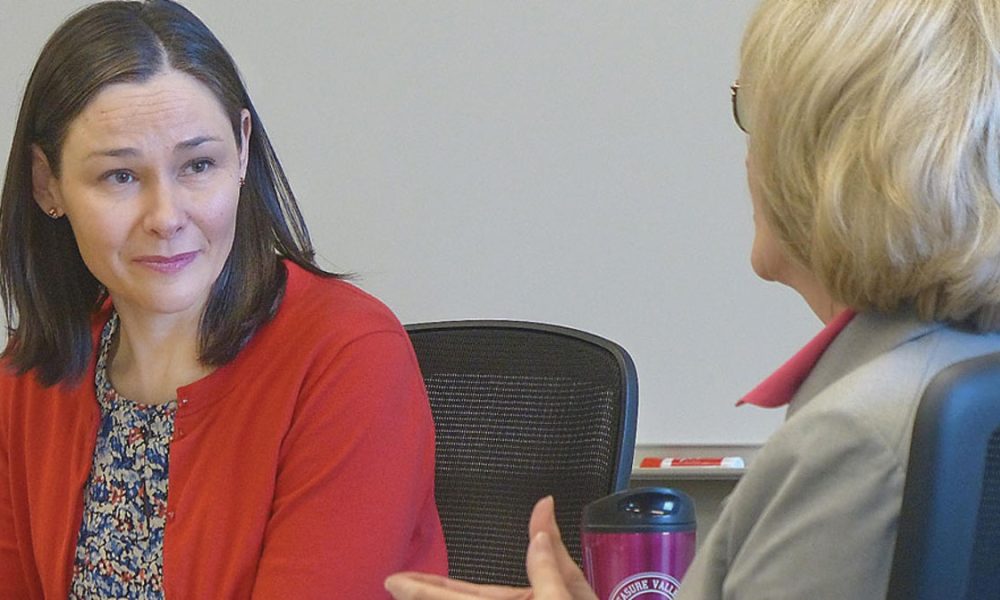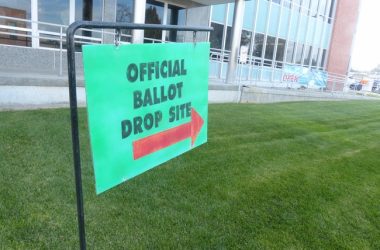
Shawna Peterson, the chair of the Eastern Oregon Border Economic Development Board listens to fellow board member Dana Young during a meeting earlier this year. The board is working on a number of economic development blueprints, including a way to boost housing locally. (The Enterprise/File).
ONTARIO – The state board assessing economic needs in Malheur County is moving towards proposing loosening restrictions on rural home construction to allow more housing.
The Eastern Oregon Border Economic Development Board is pushing to finish the proposal in advance of the Legislature convening in January.
The idea is among several that the seven-member board is considering to spur local job creation. Earlier this year the board identified six crucial challenges for local economic growth and created work groups to tackle each one.
While the list covered topics from technical training programs to the cost of electricity along the border, rural land use stood out, said board chair Shawna Peterson.
“It is our biggest policy deal,” said Peterson.
Peterson said the difference in land use laws between Oregon and Idaho is stifling growth in Malheur County.
“All you have to do is look at our side of the river versus Idaho and it is impairing our ability to be competitive,” said Peterson.
But land use issues in Oregon can be complicated and a potential flashpoint between local officials and state authorities. That is why, Peterson said, the border board is moving slowly and methodically.
“We are really building relationships to be collaborative, so we can succeed,” said Peterson.
Success will be carving out special rules to apply along a 20-mile border with Idaho that allows more flexibility in land use laws.
The aim, said Peterson, will be to spark housing development.
“Right now, our biggest problem seems to be rural residential development. If you look at our landscape and look across the river, there seems to be a good demand for ranchette housing,” said Peterson.
More housing opportunities in the county would help the economy, Peterson said.
“It would grow our population and our tax base,” said Peterson. “We don’t want a subdivision in every field, but this isn’t the Willamette Valley.”
Ralph Poole, an Ontario business executive and member of the border board, agreed with Peterson.
“If we are going to get industry and new jobs, we got to have places for those people to live. A lot of those people are moving into Idaho. We don’t want that. The more taxpayers in our county or cities or both the better off we are going to be,” said Poole.
State regulations now don’t permit rural home construction on anything less than 80 acres in farm zones and 160 acres on rangeland.
Peterson said the board isn’t proposing opening productive range or farm land for subdivisions.
Instead, she said, the focus will be on using land that is not suitable for farming yet still restricted regarding lot sizes.
“We really do want to preserve farmland but think that some goals could be met by opening up less productive land for rural housing,” said Peterson.
Board member Tiffany Cruickshank, an executive with Snake River Produce in Nyssa, said there is a lot of interest locally about land use.
“As a group, we feel like it is something to pursue,” said Cruickshank.
The proposal to allow more housing is still being developed, Peterson said.
“It lacks a little definition. We have to be very sensitive to that (land use rule changes) being a lightning rod in Salem,” said Peterson.
Yet finding a way to shift the balance of economic power across the Snake River to Malheur County is important, said Peterson.
“The first step is to figure out what state leaders will partner with us,” said Peterson. Peterson said the board recently reached out to Jim Rue, the director of the state Land Conservation and Development Department.
“We will meet with him to do some foundational work to make sure that our recommendation will be well received and to craft the recommendation so that it has a chance to become a reality,” said Peterson.
Any land use policy change proposal will be a balancing act, said Peterson.
“We still want to maintain some of the really valuable things about Oregon’s land use policy,” said Peterson.
The border board has been busy this month. After a break in July, the board met Aug. 7, Monday and will convene again Aug. 27. All the meetings are at Treasure Valley Community College.
The board finalized its project plan earlier this month. The project plan outlines the board’s vision statement, charter and grant and loan process.
“It is a game-plan for what we are going to do – to give the public an idea of what we are doing and keep us on track,” said Peterson.
The Legislature allocated to the board $5 million for grants and loans for eco- nomic development and job creation.
Peterson said the board is still working out the details on the loan and grant process but hopes to have a final draft by October.
“The how and why and the application process will follow so that people will know whether they want to pursue one of our grants,” said Peterson.
The board also created work groups to tackle five other issues.
Those include sub-committees on workforce development, energy and natural resources, transportation and communication, community development and trade and professional certifications between Oregon and Idaho.
Reporter Pat Caldwell: [email protected] or 541-963-3377.




